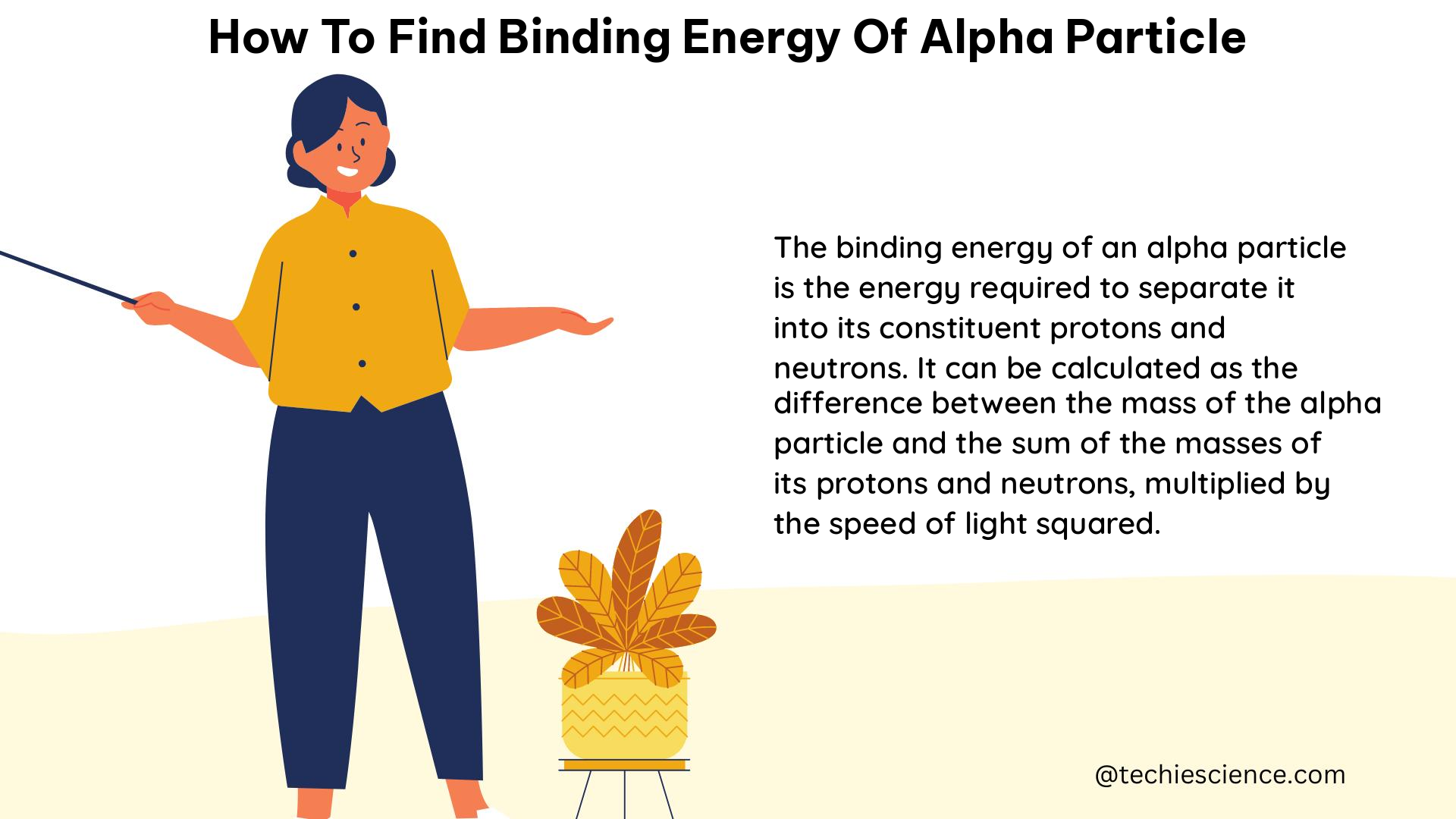The binding energy of an alpha particle, which is the helium nucleus (4He), is a crucial concept in nuclear physics. It represents the energy required to break apart the alpha particle into its constituent protons and neutrons. Understanding the binding energy of an alpha particle is essential for studying nuclear reactions, radioactivity, and the stability of atomic nuclei. In this comprehensive guide, we will delve into the step-by-step process of calculating the binding energy of an alpha particle.
Mass Defect and Binding Energy Formulas
To find the binding energy of an alpha particle, we need to first calculate the mass defect, which is the difference between the actual mass of the alpha particle and the sum of the masses of its constituent particles (two protons and two neutrons). The mass defect formula is:
$\Delta M = (2M_p + 2M_n) – M_\alpha$
where:
– $\Delta M$ is the mass defect
– $M_p$ is the mass of a proton
– $M_n$ is the mass of a neutron
– $M_\alpha$ is the mass of the alpha particle
Once we have the mass defect, we can calculate the binding energy using the following formula:
$BE = \Delta M \times c^2$
where:
– $BE$ is the binding energy
– $c$ is the speed of light (approximately 3.0 × 10^8 m/s)
Given Values

To calculate the binding energy of an alpha particle, we need to know the following values:
- Mass of a proton ($M_p$): 1.007277 a.m.u. (atomic mass units)
- Mass of a neutron ($M_n$): 1.00866 a.m.u.
- Mass of the alpha particle ($M_\alpha$): 4.001265 a.m.u.
- Speed of light squared ($c^2$): 931.4813 MeV (million electron volts)
Step-by-Step Calculation
-
Calculate the mass defect using the formula:
$\Delta M = (2M_p + 2M_n) – M_\alpha$
$\Delta M = (2 \times 1.007277 + 2 \times 1.00866) – 4.001265$
$\Delta M = 2.014554 – 4.001265$
$\Delta M = 0.030609$ -
Calculate the binding energy using the formula:
$BE = \Delta M \times c^2$
$BE = 0.030609 \times 931.4813$
$BE = 28.511 \text{ MeV}$
Therefore, the binding energy of the alpha particle is approximately 28.511 MeV.
Significance of Binding Energy
The binding energy of an alpha particle is a crucial parameter in understanding the stability and behavior of atomic nuclei. A higher binding energy indicates a more stable nucleus, as more energy is required to break it apart. Conversely, a lower binding energy suggests a less stable nucleus, which may be more prone to radioactive decay or nuclear reactions.
The binding energy of an alpha particle is also important in the study of nuclear fusion and fission processes. In nuclear fusion, the combination of lighter nuclei to form heavier nuclei releases energy, while in nuclear fission, the splitting of heavier nuclei into lighter nuclei also releases energy. The difference in binding energies between the initial and final nuclei is the source of this energy release.
Applications and Implications
The knowledge of the binding energy of an alpha particle has numerous applications in various fields of physics and technology:
-
Nuclear Reactors: Understanding the binding energy of alpha particles is crucial in the design and operation of nuclear reactors, where the fission or fusion of nuclei is the primary source of energy.
-
Radioactive Decay: The binding energy of an alpha particle is directly related to the stability of the nucleus and the likelihood of radioactive decay. This information is essential in the study of radioactive materials and their behavior.
-
Nuclear Astrophysics: The binding energy of alpha particles plays a crucial role in understanding the formation and evolution of stars, as well as the nucleosynthesis of heavier elements in the universe.
-
Medical Applications: The knowledge of alpha particle binding energy is relevant in the field of nuclear medicine, where radioactive isotopes are used for diagnostic and therapeutic purposes, such as in cancer treatment.
-
Nuclear Weapons: The binding energy of alpha particles is a fundamental concept in the development and understanding of nuclear weapons, as it is directly related to the energy released in nuclear fission and fusion reactions.
Conclusion
In this comprehensive guide, we have explored the step-by-step process of calculating the binding energy of an alpha particle. By understanding the mass defect formula and the binding energy formula, as well as the relevant physical constants, we can determine the binding energy of the alpha particle to be approximately 28.511 MeV. This knowledge is crucial in various fields of physics, from nuclear reactors and radioactive decay to nuclear astrophysics and medical applications. By mastering the techniques presented in this guide, physics students and researchers can deepen their understanding of the fundamental properties of atomic nuclei and their role in the natural world.
References:
- Vedantu. (n.d.). Find the binding energy of an α-particle. Retrieved from https://www.vedantu.com/question-answer/find-the-binding-energy-of-an-alpha-particle-class-12-physics-cbse-5fbb459b2afe2a6ade85cc5b
- YouTube. (2020). Calculate the binding energy of an alpha particle from the following data:
mass of _1^1H .... Retrieved from https://www.youtube.com/watch?v=1yyv5VSzCOw - YouTube. (2020). Calculate the binding energy if an
alpha-particle in MeV Given. Retrieved from https://www.youtube.com/watch?v=6S9Nfpyf0Ns

The lambdageeks.com Core SME Team is a group of experienced subject matter experts from diverse scientific and technical fields including Physics, Chemistry, Technology,Electronics & Electrical Engineering, Automotive, Mechanical Engineering. Our team collaborates to create high-quality, well-researched articles on a wide range of science and technology topics for the lambdageeks.com website.
All Our Senior SME are having more than 7 Years of experience in the respective fields . They are either Working Industry Professionals or assocaited With different Universities. Refer Our Authors Page to get to know About our Core SMEs.